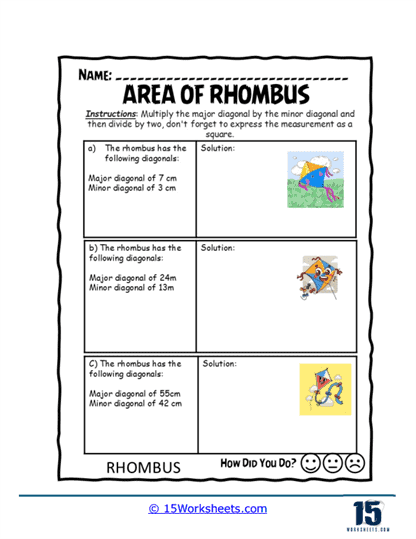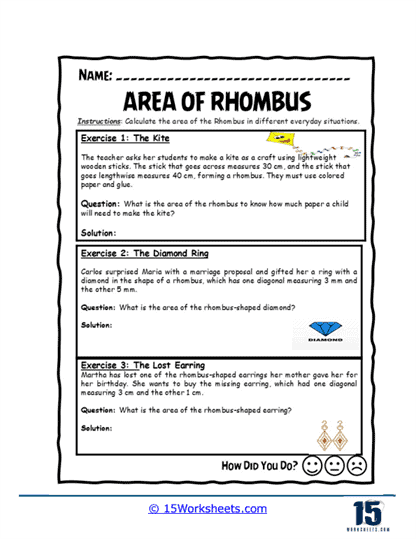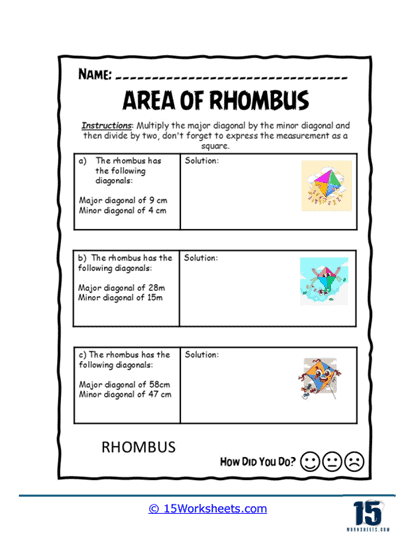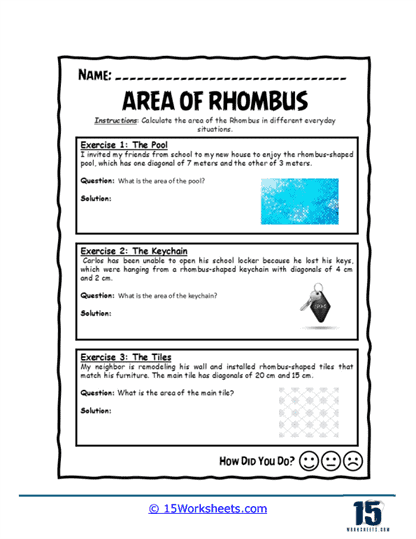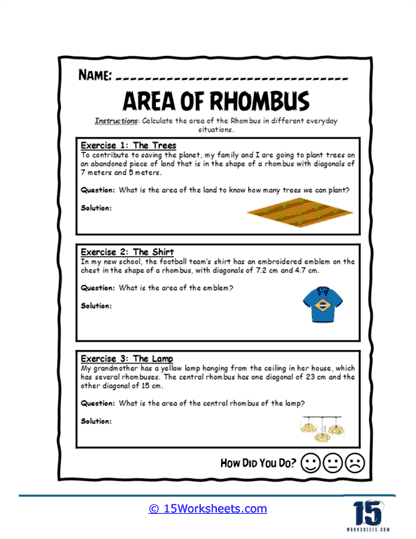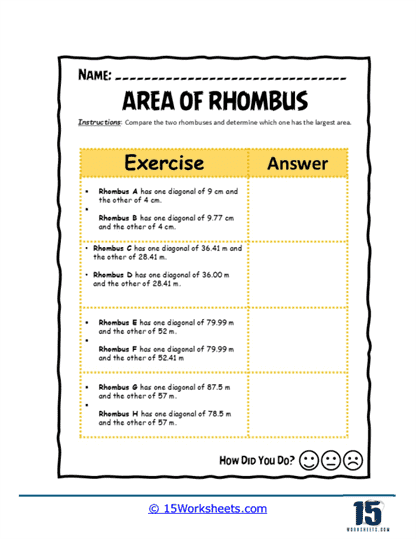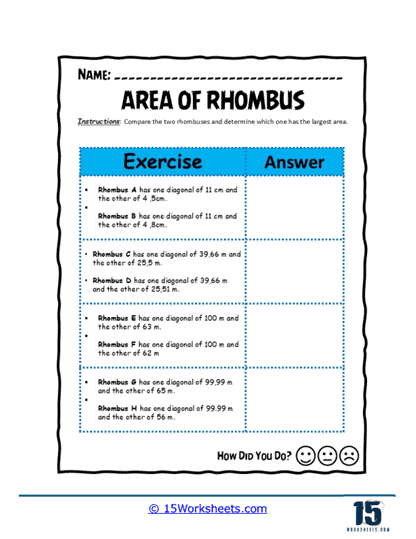Area of Rhombus Worksheets
About Our Area of Rhombus Worksheets
Understanding geometric shapes is a fundamental aspect of mathematics, and among them, the rhombus holds a special place due to its unique properties. This worksheet collection is designed to provide students with a structured, engaging, and practical approach to mastering this important topic.
From fundamental formula applications to real-world problem-solving, this collection ensures that students gain a thorough understanding of how to calculate the area of a rhombus using different methods. Whether used in the classroom, at home, or as part of a supplementary learning program, these worksheets provide a step-by-step guide that makes learning both accessible and enjoyable.
What’s Inside?
This worksheet set is designed to progressively build student understanding of the area of a rhombus through a variety of exercises. The worksheets include:
1. Concept Introduction and Formula Exploration
Clear and concise explanations of the area formula for a rhombus.
Step-by-step breakdowns of how to apply the formula:
Using diagonals: A ½ d1 d2
Using base and height: A = base x height
Illustrated examples to demonstrate different calculation methods.
2. Skill-Building Exercises
- Basic computation practice: Finding the area of a rhombus given diagonal lengths or base and height.
- Fill-in-the-blank exercises that reinforce key concepts and formulas.
- Multiple-choice questions testing conceptual understanding.
- Error analysis activities, where students identify and correct mistakes in given solutions.
3. Applied Problem-Solving
- Word problems that relate to real-life applications (e.g., finding the area of a kite-shaped garden or a tiled floor design).
- Comparative exercises where students analyze the relationship between different quadrilaterals (e.g., contrasting a rhombus with a square or parallelogram).
- Challenge questions that require multi-step reasoning and deeper critical thinking.
Key Skills Developed
Mastering the area of a rhombus through these worksheets strengthens mathematical and analytical skills by helping students develop fluency in applying area formulas in various scenarios. They will practice using the diagonal-based formula as well as the base-height method, reinforcing their understanding of when and how to use each approach. Additionally, the worksheets encourage algebraic reasoning by requiring students to manipulate and rearrange equations, solve for missing values, and work through multi-step problems. These skills contribute to logical problem-solving abilities, enabling students to approach geometry with confidence and precision.
Beyond the numbers, these worksheets deepen geometric understanding by allowing students to explore the unique properties of rhombuses and how they relate to other quadrilaterals. Students will learn to identify rhombuses in different orientations, understand the significance of equal sides, perpendicular diagonals, and symmetry, and compare rhombuses to parallelograms and squares. By analyzing diagrams, drawing rhombuses on coordinate planes, and using real-world examples, students will enhance their visual and spatial awareness, key to mastering geometry. This hands-on learning ensures they don’t just memorize formulas but truly grasp the fundamentals of geometric reasoning.
These worksheets foster critical thinking and real-world application skills by challenging students to apply their knowledge beyond simple calculations. Through word problems and practical exercises, students will analyze how diagonal lengths, side lengths, and angles interact, strengthening their logical reasoning skills. Additionally, tasks that require error analysis and step-by-step problem-solving teach students to critically evaluate mathematical solutions, a skill that extends beyond geometry into broader areas of learning. By engaging with these diverse activities, students become more adaptable thinkers, prepared to tackle complex math challenges with confidence.
Real-World Applications
The concept of the area of a rhombus extends beyond textbooks-it plays a significant role in real-world applications across multiple industries. In architecture and engineering, rhombus-based calculations are essential in structural design, flooring patterns, and bridge construction. Architects and civil engineers frequently incorporate rhombus-shaped elements in tiles, windows, and support structures, using precise area calculations to ensure efficient material use and aesthetic appeal. Similarly, mechanical engineers rely on rhombus geometry in designing trusses, gears, and mechanical linkages, ensuring strength and stability in various applications. These practical connections demonstrate how geometry is a foundational tool in building and design.
In art, aesthetics, and creative industries, rhombuses are widely used in patterns and visual design. Mosaic artists, textile designers, and graphic artists employ rhombus-shaped motifs in their work, creating visually appealing compositions that balance symmetry and proportion. Origami enthusiasts and paper engineers use rhombus folds to construct intricate, symmetrical models, emphasizing how geometric knowledge extends into creative problem-solving. Even in digital design, rhombus grids are used in logos, web layouts, and animation frameworks, illustrating how mastering geometric concepts enhances creativity and innovation.
The significance of the rhombus shape also appears in sports, recreation, and scientific research. Baseball diamonds, a key example of rhombus geometry, rely on precise area measurements for field layout and boundary placement. Kite designers use the area of rhombuses to calculate material requirements, ensuring optimal flight performance. In the sciences, crystallography, physics, and cartography all utilize rhombus-based calculations. Scientists studying molecular structures and tessellations frequently encounter rhombus formations, while geographers apply these concepts in land surveying and mapping. This real-world relevance reinforces the value of mastering the area of a rhombus, equipping students with skills applicable across diverse fields and professions.
This worksheet collection is more than just a set of exercises-it is a comprehensive learning tool designed to build mathematical confidence and critical thinking. By guiding students through foundational concepts, step-by-step problem-solving, and real-world applications, these worksheets ensure a well-rounded understanding of geometric principles. The structured progression from basic formula application to complex reasoning tasks allows learners to deepen their knowledge at their own pace while reinforcing essential math skills.
Beyond academic success, this collection cultivates practical problem-solving abilities that extend into real-life situations. Whether students aspire to careers in architecture, engineering, design, or science, or simply wish to strengthen their logical thinking, mastering the area of a rhombus equips them with valuable skills. The integration of hands-on activities, visual exercises, and real-world connections makes learning more engaging and meaningful, transforming geometry from an abstract subject into a tool for innovation and creativity.




